Navy and Cream Area Rugs: Aesthetic and Practical Guide
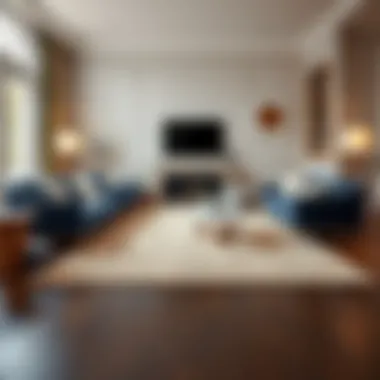

Intro
The selection of area rugs can serve as a defining characteristic within any space—a combination of color, texture, and style all coming together to create the desired mood and functionality of a room. Among the plethora of options available, navy and cream area rugs stand out as a particularly appealing choice, blending boldness with subtlety. But why do these hues hold such a special place in modern home design? Understanding the nuances behind this dynamic color combination can illuminate its efficacy in various settings.
In this article, we shall embark on an intricate journey through the world of navy and cream area rugs. Not only will we dissect their aesthetic appeal, but we will also delve into practical considerations: choosing materials, caring for your rug, and placing it in harmony with existing furniture. With insights that extend from current design trends to budgeting tips for every wallet, we aim to guide homeowners and design enthusiasts alike in making intelligent decisions that enhance their living environments.
Ultimately, it is not just about laying a rug on the floor. It’s about finding an element that resonates with the soul of your space, showcasing textures, patterns, and compatibility with your unique home style. As we unravel the threads of this color palette, prepare to gain a deeper understanding of how navy and cream can elevate both aesthetic and practical aspects of your home.
Prolusion to Navy and Cream Area Rugs
When it comes to interior design, the choice of colors and patterns can make or break a space. Navy and cream area rugs stand out as a distinctive pairing that brings a blend of sophistication and warmth to any room. Using these two colors effectively can transform an ordinary living space into an inviting and stylish environment. This article delves deep into the aesthetic appeal as well as the practical aspects of navy and cream area rugs, making it essential reading for homeowners, designers, and DIY enthusiasts alike.
One of the compelling reasons to consider navy and cream rugs is their versatility. They successfully fit into a myriad of design styles, from contemporary to traditional, and everything in between. The richness of navy pairs perfectly with the softness of cream, creating a striking yet comforting ambiance. Whether you’re looking to add interest to a minimalist space or seeking a foundation for a more eclectic design, this color combination has you covered.
Another important factor is the practical side of choosing a rug. Area rugs serve multiple functions; they can tie a room together, add texture, and even improve acoustics in larger spaces. Choosing navy and cream options can often enhance the overall feel of a home. These rugs serve as an anchor point, tying together various shades and styles throughout the room, allowing layers of decor to coexist beautifully.
Moreover, the psychological effects of colors play a significant role in home design. Navy is often associated with trust and calmness, while cream evokes feelings of warmth and comfort. Together, they create a balanced atmosphere that can promote relaxation and well-being. This is particularly beneficial in such pivotal spaces as the living room or bedroom.
"Choosing the right area rug is about harmonizing your space and expressing personality. Navy and cream rugs do just that, blending elegance with a homey feel."
Lastly, we cannot ignore the impact that area rugs have on the practicality of cleaning and maintenance. High-quality options in these colors are often designed to withstand everyday wear and tear while still looking great. They can even hide stains better than lighter options might, thus offering a more durable alternative for high-traffic areas.
In summary, navy and cream area rugs present a unique blend of aesthetics and function. As we continue this exploration, we will go more in-depth into the underlying color theory, material choices, design versatility, and maintenance tips associated with these appealing home furnishings. With the right knowledge, you can elevate your space while also considering the longevity and style of your investment.
The Color Theory Behind Navy and Cream
Color sets the mood of any space, acting as a silent yet powerful communicative force. Understanding the color theory, especially with shades like navy and cream, is vital for homeowners, designers, and DIY enthusiasts alike. Together, these colors create a visually stimulating contrast that can echo elegance, calmness, and sophistication in different settings.
Understanding the color dynamics and synergistic effects of navy blue and cream is essential. Navy is often associated with authority and professionalism, while cream brings warmth and a touch of softness. When paired, they achieve a harmonious balance that doesn’t just appeal visually; it evokes a sense of well-being.
Understanding Complementary Colors
Complementary colors are those that stand opposite each other on the color wheel. They enhance each other’s vibrancy when paired, making spaces more colorful and inviting. Navy blue and cream, while not directly opposites, create an engaging visual dialogue. This balance can serve as a canvas for incorporating various styles and elements in decor.
- Soothing Balance: Navy can serve as a deep foundation, while cream softens and lightens the overall aesthetic, reducing overwhelming sensations. This interplay makes spaces feel both rich and welcoming.
- Style Chameleon: Whether you’re leaning towards a beachy vibe or something more industrial, navy and cream can fit any style. Their versatility means you can play with textures and accessories without going overboard.
"Colors create a mood; the interplay between hues can be a powerful tool in setting a room's tone."
Psychological Effects of Color Choices
Colors impact our emotions and behaviors in subtle yet significant ways. Understanding the psychological effects of navy and cream can enhance decision-making for interior styling.
- Navy Blue: This color has been shown to promote calmness. It can instill a sense of order and stability.
- Cream: On the other hand, this hue is known for evoking feelings of warmth and comfort. It reduces stress levels, making spaces feel inviting.
The combination can encourage relaxation, making them ideal choices for common areas like living rooms or bedrooms. When selecting a navy and cream area rug, consider how you want your space to feel. Do you want it to be more calming for a workspace or energizing for a lively social gathering?
Materials Used in Navy and Cream Area Rugs
When it comes to decorating living spaces, the materials used in area rugs play a pivotal role in the aesthetic, durability, and comfort of the home. Navy and cream area rugs, specifically, can elevate a room's visual appeal when paired with the right fabric choices. Understanding the materials available not only highlights their advantages but also helps in making informed decisions to suit various preferences, budgets, and practical needs.
Natural Fiber Rugs
Natural fibers offer an organic touch that resonates with many homeowners looking for eco-friendly and breathable options. They bring warmth and texture, which is essential when considering rugs for areas in the home that need both style and functionality.
Wool
Wool is often considered the king of natural fibers. Its soft texture and warmth can make any space feel cozy. One standout aspect of wool is its ability to retain heat, which is especially beneficial in colder climates. It’s also naturally stain-resistant, making it a poplar choice for high-traffic areas. Moreover, wool rugs are durable and can withstand wear and tear over time. However, this material could be more expensive than synthetic options and may require periodic maintenance to keep it looking its best.
Jute
Jute brings a rustic charm that many find appealing. This fiber is biodegradable and thus an excellent choice for those mindful of their environmental footprint. It offers a coarse texture that can act as a natural contrast to the smooth feel of navy and cream. One notable feature of jute is its ability to provide a non-slip surface, which makes it an ideal choice for kitchen or dining areas. On the flip side, jute can be less stain-resistant and may not hold up as well in wet conditions, so it’s best suited for dry environments.
Sisal
Sisal is another robust natural fiber that offers a unique texture. This material is known for its toughness and ability to withstand heavy footfall. If you’re looking for something that can handle everyday use, sisal is a solid option. It has a natural, earthy appeal that aligns well with a navy and cream palette, giving the space an organic feel. However, like jute, sisal doesn’t they hold up well in moist conditions, making it crucial to keep it dry and clean to maintain its integrity.
Synthetic Fiber Options
Synthetic fibers present a practical alternative to natural materials. These options tend to be more affordable and are often designed with durability and ease of maintenance in mind. They can imitate the look of natural fibers while being resistant to staining and fading.
Polyester
Polyester is a colorful and versatile synthetic option. Its key characteristic is resilience; this material retains its shape very well and can withstand considerable foot traffic without showing wear. Moreover, polyester rugs are often fade-resistant, keeping that rich navy or cream hue intact even when exposed to sunlight. The downside? While polyester rugs are cost-effective, they can sometimes feel less luxurious underfoot compared to their natural counterparts.
Nylon
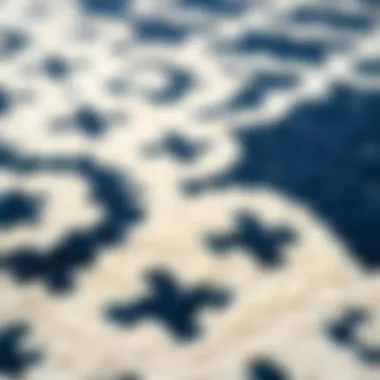
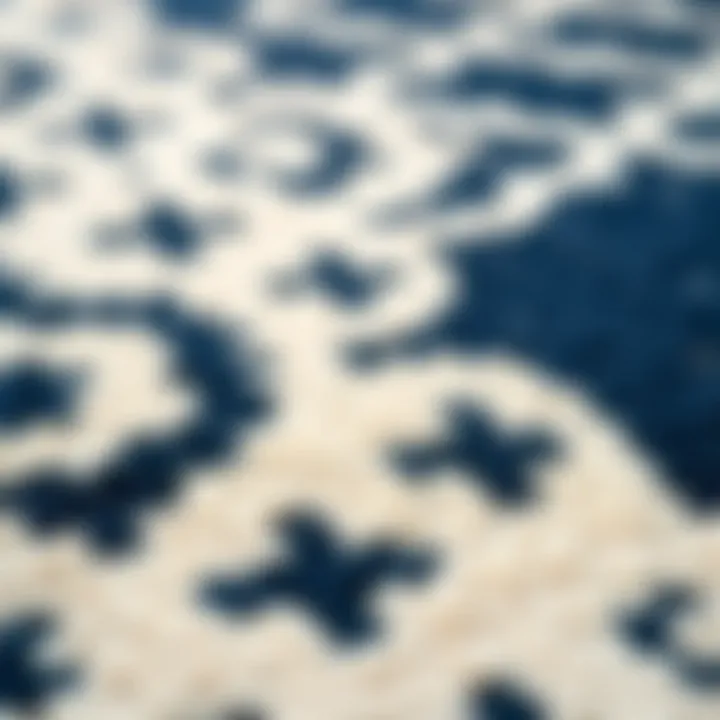
Nylon stands out for its strength and ability to maintain its vibrancy. It’s particularly popular in homes with pets and children due to its stain-resistance and durability. If you’re looking for a rug that can endure the rigors of a busy household, nylon may be your best bet. However, one must keep in mind that nylon may not have the same natural feel as wool or jute, making it a more practical but less luxurious choice.
Polypropylene
Polypropylene is the underdog of synthetic fibers, often overlooked but brimming with advantages. Its primary attribute is its water and stain resistance, which makes it a great fit for outdoor or high-traffic areas. This material can easily mimic the look of natural fibers, providing a chic appearance without the price tag. Nonetheless, like polyester, polypropylene may lack the softness of natural options, which might be a consideration depending on where the rug is placed.
"Choosing the right material for an area rug can significantly affect not just the style but also the functionality of your space."
Design Versatility of Navy and Cream Rugs
Navy and cream rugs are more than just decorative pieces; they play a pivotal role in shaping the overall aesthetics of home interiors. Their versatility in design allows them to complement a wide range of interior styles, making them a favorite choice for homeowners, designers, and DIY enthusiasts alike. This section explores how patterns, textures, and color schemes can transform your space, providing a nuanced understanding of why these rugs hold such appeal across various design frameworks.
Patterns and Textures
The right patterns and textures can help to establish a mood in your space, adding depth and dimension. From geometric designs to abstract artistic expressions, there is no shortage of options.
Geometric Designs
Geometric patterns are characterized by shapes, lines, and forms that create a visually engaging experience. These designs often exhibit symmetry and clarity, which can bring structure to a room. Their clean-cut appearance works well in modern and contemporary settings, making them a popular choice among homeowners who appreciate minimalism.
Notably, the key characteristic of geometric designs is their ability to create focal points. A navy and cream geometric rug can stand out amid neutral furnishings, creating visual interest. However, one drawback is that such patterns may overwhelm smaller spaces, making careful placement essential to achieving a balanced look.
Abstract Patterns
On the other hand, abstract patterns take a more playful approach. They blend colors and shapes in ways that evoke emotion without limiting interpretation. People often choose these rugs to express creativity and bring life to otherwise subdued spaces.
The unique feature of abstract patterns lies in their ability to resonate with individual personalities. They can effectively serve as conversation starters. However, because they can be more chaotic, it's crucial to coordinate them wisely with other elements in the room to avoid visual clutter.
Traditional Styles
Traditionally styled rugs offer timeless elegance that never seems to go out of fashion. These designs often incorporate intricate details and motifs inspired by historical patterns, making them suitable for classic or vintage-themed homes.
The key characteristic of traditional styles is their craftsmanship and detail. Such rugs can harmonize beautifully with antique furniture and embellished decor. However, one must be mindful of modern setting—traditional rugs may clash with simple, sleek furnishings, so careful consideration is needed to ensure cohesion.
Complementary Color Schemes
Color matters. The interplay between navy and cream with additional colors can significantly impact the ambiance of your home.
Contrasting Colors
In the realm of design, contrasting colors can create stunning visuals. The boldness of navy coupled with the softness of cream allows for effective contrasts with brighter hues like orange or mustard yellow.
The beneficial aspect of contrasting colors is their ability to energize a space and make it visually striking. A rug that fuses navy and cream with dashes of vibrant colors can enhance the vitality of an otherwise dull room. However, too many contrasts can create visual discord, so moderation is key.
Neutral Pairings
In contrast, neutral pairings provide a calming and cohesive atmosphere. Navy and cream rugs match well with colors like beige, gray, and taupe, making them excellent choices for those looking to foster a serene environment.
A key characteristic of neutral pairings is that they create balance, allowing other design elements to shine without being overbearing. This approach can evoke tranquility, but it may lack the bold flair some homeowners desire.
Accent Colors
Adding accent colors is another effective technique for enhancing design impact. By introducing subtle hues such as gold or blush, you can create layers of contrast and visual interest.
The beneficial aspect of incorporating accent colors is their ability to introduce warmth and liveliness without overwhelming the established palette. Yet, too many accents can clutter the space and detract from its overall look.
Overall, the versatility of navy and cream rugs allows for endless design possibilities. By understanding the various patterns, textures, and complementary color schemes, you can make an informed decision that enhances your home’s interior aesthetic.
Choosing the Right Size for Your Space
Selecting the appropriate size for your navy and cream area rug isn’t just about aesthetics; it plays a vital role in the overall functionality and feel of your room. A rug can dramatically influence the perceived dimensions of your space and impact the existing decor. When chosen correctly, it can tie a room together seamlessly, adding warmth and character. However, when the size is off—be it too small or overwhelming—it can create unease, drawing attention for all the wrong reasons.
Correct sizing helps in accomplishing a few significant outcomes. It establishes proper boundaries, particularly in open-concept areas where different zones are defined. Furthermore, the right rug size can amplify comfort underfoot, making your space feel more inviting and coherent. Conversely, an ill-fitted rug could lead to disconnects between furnishings or inadvertently diminish the intended aesthetic flow.
Given these benefits, understanding how to measure your room accurately and the various size options available can guide homeowners and designers alike in making informed choices.
Measuring Your Room
To successfully choose the right-sized rug, it begins with a simple yet crucial step—measuring your room. While this might seem straightforward, ensuring precision can save you from potential headaches down the line. Start by grabbing a measuring tape and the following tips:
- Define the Area: Prioritize which area you want the rug to occupy, whether that’s a living room, dining space, or bedroom. This will give a clearer picture.
- Measure Dimensions: Take measurements of the length and width of the room, including doors and any obstacles like furniture that may influence the rug’s placement.
- Leave Breathing Room: When jotting down your measurements, consider leaving some space around the edges of the rug to allow for pathways and added visual comfort.
Using these measurement guidelines, you can make a more informed decision about the size that balances both style and purpose in your space.
Common Size Options for Area Rugs
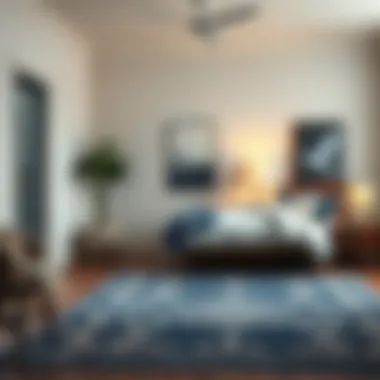

With your room measured, it’s time to dive into the variety of rug sizes available. Here’s a quick look at how small, medium, and large area rugs can fit into your home decor:
Small Area Rugs
Small area rugs can serve as delightful additions to many spaces. Typically, these rugs range from 2x3 to 4x6 feet. They are often used in entryways, under coffee tables, or in front of kitchen sinks.
One key characteristic of small rugs is their versatility; they can easily be moved or swapped without much hassle. This makes them a popular choice for those who enjoy changing their design frequently. Additionally, they offer the chance to introduce a splash of color or texture in a subtle way. However, a notable disadvantage is that they may not provide enough coverage for larger furniture arrangements, leading to a sense of disconnect in the room.
Medium Sized Rugs
Medium-sized rugs, generally between 5x7 and 8x10 feet, provide a middle ground for those seeking coverage without overwhelming the space. They are often favored in living rooms or under dining tables, where they can anchor the furniture effectively.
The beauty of medium rugs lies in their ability to create cohesion while allowing space for mobility. They can define areas within a larger room and add character with patterns and textures. Nonetheless, they still require careful consideration because if they’re too small for the arrangement, it can make the area feel cluttered or incomplete.
Large Area Rugs
Large area rugs, which can be 9 feet or larger, are perfect for those wanting to make a statement in their space. They cover more ground and often serve as a primary focal point in a room.
A major advantage of large rugs is their potential to unify the space, creating a harmonious environment. They can accommodate most furniture pieces, allowing for ample walking space around the seating area. However, it’s crucial to ensure that the rug is proportional to the size of the room. An excessively large rug in a compact area may overwhelm the space, offering a sense of confinement.
Remember: Selecting the right-sized rug requires balancing aesthetics with functional needs. Understanding the nuances of size can help ensure that your navy and cream area rug brings both comfort and style to your home.
In summary, size matters significantly when it comes to area rugs. By measuring correctly and choosing between small, medium, or large options, you’ll be better equipped to find a rug that enhances your living spaces beautifully.
Placement Strategies for Navy and Cream Rugs
When it comes to navy and cream area rugs, the placement is crucial, not just for aesthetic appeal but also for functionality. These rugs can anchor a room, draw the eye, and even define different spaces within a larger area. Here’s a closer look at effective placement strategies that resonate well with homeowners and designers alike.
Living Room Arrangements
In the living room, the rug can serve as the focal point. When selecting its position, think about traffic flow and furniture layout. Ideally, place the area rug so that the front legs of sofas and chairs sit on the rug while the back legs rest on the floor. This method creates a unified space, giving the room a cozy feel.
- Anchor the Furniture: By positioning the rug under key pieces like the couch and coffee table, you create a coherent look. It’s fundamentally important to ensure the rug is large enough to accommodate this setup. If the dimension is off, it can feel disjointed.
- Balance with Color: Navy and cream rugs can complement other textures and tones in the room. If you have pastel-colored walls, the rich navy can add depth, creating a contrast that’s visually pleasing. A careful selection of nearby elements, such as cushions or curtains, can enhance this balance further.
Placement isn’t just about the rug itself; it’s about how it interacts with everything surrounding it.
Dining Area Considerations
In dining spaces, the rug should ideally extend beyond the edges of the table, allowing chairs to slide out without catching on the fabric. A common recommendation is for the rug's edges to extend at least 24 inches beyond the table.
- Style Meets Practicality: A navy and cream rug beneath a dining table can soften the look, especially when paired with wooden or metal furniture. This creates a fine balance between style and comfort.
- Color Coordination: The navy hue can ground the dining area while creams can brighten it up, subtly guiding the eye through the room.
Also, consider durability; dining areas can be messy, so selecting a material that allows for easy cleaning is a great idea.
Bedroom Placement Tips
In bedrooms, area rugs not only contribute to aesthetics but also add warmth, which can dramatically change the comfort level of the room. Placing a navy and cream rug at the foot of the bed creates a visual anchor and enhances the overall style.
- Layering Effect: Consider layering a smaller rug over a larger one to add dimension. It can create depth in the decor, making the room more inviting.
- Functionality in Mind: Positioning the rug close to the bed ensures you have a soft surface to step on first thing in the morning, which is a delightful touch. Whether you prefer it fully under the bed or just partially extending out, it’s about what fits best for your space.
By adhering to these strategies, homeowners can ensure that their navy and cream area rugs serve as beautiful yet practical additions to their living environments. It's about finding a balance that communicates elegance and comfort—much like the rugs themselves.
Maintaining Your Navy and Cream Area Rug
The beauty of navy and cream area rugs is not just in their design but also in how they can elevate the ambience of a room. However, maintaining their appearance is crucial to ensure they continue to enhance your space for years to come. Proper care involves regular cleaning, preventive maintenance, and a bit of know-how about the right methods to keep these rugs looking fresh.
Cleaning Techniques
Regular Vacuuming
Regular vacuuming is a key part of keeping your navy and cream area rug in tip-top shape. It helps to remove dirt, dust, and pet hair that can settle deep within the rug fibers. This is essential because dirt can dull the color and texture of the fabric over time. What’s nice about regular vacuuming is its ease; it’s a quick daily chore that anybody can do.
With a vacuum cleaner equipped with a brush attachment, you can gently tease up dirt without risking any harm to the rug. Note that using a beater bar is a no-go, especially with delicate fibers like wool or cotton. The benefit here is obvious—regular vacuuming helps in prolonging the life of your rug. But be mindful—over-vacuuming, especially with aggressive settings, can cause wear and tear.
Spot Cleaning Procedures
Spot cleaning is somewhat of a superhero move for cleaning stains on rugs. When an accidental spill happens, acting fast can make all the difference. A simple mixture of water and mild detergent or a specialized rug cleaner can do wonders. Apply this solution to a clean cloth and dab, don’t rub. This helps lift the stain without spreading it. A key aspect of spot cleaning is its effectiveness in maintaining the overall look of your rug. Unlike extensive cleaning methods, it’s non-invasive and doesn’t disrupt the fibers of the rug significantly, which is a bonus. However, spot cleaning isn’t a catch-all solution. Some stains—think red wine or oily foods—might require professional attention to avoid damaging the fibers or color.
Deep Cleaning Recommendations
Deep cleaning isn’t just an occasional chore; it's a necessary part of rug maintenance, especially for those navy and cream rugs that see a lot of traffic. Depending on the rug materials, you might need to opt for professional cleaning, or you can sometimes do it at home using a steam cleaner. Deep cleaning removes accumulated allergens, dirt, and odours so that your living space remains fresh and inviting. A defining characteristic of deep cleaning is its thorough nature—unlike vacuuming, it digs deeper to target embedded dirt. Bear in mind that this method could take a while, as you'll need to allow the rug to dry completely before using it again. Too wet could lead to mildew, which spells trouble.
Preventive Maintenance
Using Rug Pads
Using rug pads beneath your navy and cream rugs is akin to giving them a protective hug. A good quality rug pad prevents slipping and sliding, which can lead to wear and tear, especially in high-traffic areas. Additionally, these pads add a cushioning effect that can save both your rugs and the floor beneath.
They come in various materials, but felt pads are often recommended for their ability to absorb impact and extend the life of the rug. On the flip side, choosing the wrong kind—like rubber pads—can sometimes lead to discoloration or even damage to the underside of the rug due to heat retention.
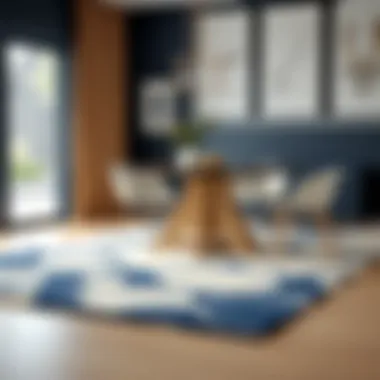
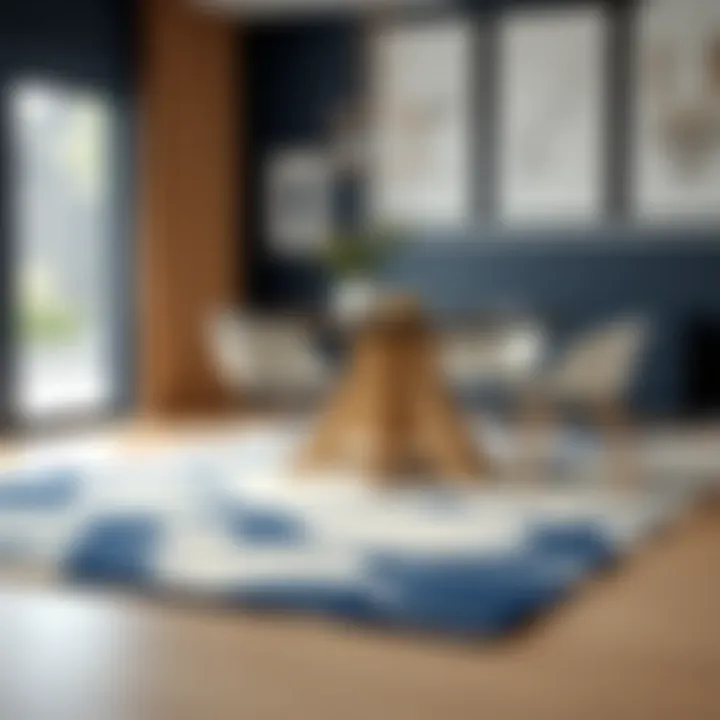
Managing Sun Exposure
Sunlight is a friend and foe when it comes to rugs. While it can highlight the rich hues of navy and cream, prolonged exposure can fade those colors over time. This makes managing sun exposure crucial if you want your rug to stay vibrant. Employ sheer curtains or UV window films to filter sunlight while still brightening the room. A practical tactic involves rearranging furniture or rotating the rug occasionally. This way, certain sections aren't subject to prolonged sunlight exposure. While curtains and rugs can work wonders, they do require some initial investment. Consider it a way of ensuring the longevity of your investment in style.
Rotating Rugs
Rotating your rugs periodically is an often-overlooked aspect of maintaining their appeal. Just like sunscreen prevents skin damage, rotating the rug prevents uneven wear from constant foot traffic in one area. Every six months is generally a good rule of thumb. This simple action not only distributes wear but also gives your room a mini makeover without spending a dime. Take note though—heavy rugs can be cumbersome to move, so having someone help can be useful to prevent straining your back.
Sustainable Options in Navy and Cream Rugs
In today's world, where environmentally conscious choices are becoming a priority for many homeowners and interior designers, sustainable options in navy and cream rugs play a vital role. The adoption of eco-friendly practices not only satisfies personal aesthetics but also signifies a deeper commitment to our planet. This section delves into the importance of selecting sustainable area rugs, highlighting the benefits and considerations for making informed choices in your rug selections.
By choosing sustainable materials and ethical production practices, you can enhance your home while minimizing your environmental impact. With awareness of pollutants and the effects of fast fashion, savvy consumers are leaning towards alternatives that resonate with their values.
Eco-Friendly Materials
When it comes to selecting navy and cream area rugs, consider the materials that align well with sustainability. Look for rugs crafted from natural fibers, which often hold an ecological edge over synthetic counterparts. For instance, fibers like wool and jute are renewable, biodegradable, and usually produced with a lower ecological footprint.
Some key eco-friendly materials include:
- Wool: Not only is it soft and warm, but wool rugs are sustainable because they are derived from sheep, which can regrow their fleece annually. Additionally, wool is known for its durability and natural resistance to stains and dirt, making it a practical choice.
- Jute: An underrated hero in sustainable design, jute is a fibrous plant that grows quickly in various climates. Rugs made from jute are often handwoven and serve as a versatile grounding element in various room styles from rustic to modern.
- Organic Cotton: Produced without harmful pesticides, organic cotton rugs can be a softer alternative that contributes to a healthier indoor environment.
By selecting rugs made from these materials, you're not just adding a stylish touch to your living space, but also investing in sustainability.
Ethical Production Practices
While selecting the right eco-friendly materials is crucial, understanding the production methods is equally important. Ethical production practices ensure the welfare of workers and the environment. It's vital to buy rugs from manufacturers that adhere to fair labor standards, as this promotes sustainable livelihoods.
Consider these points when examining the ethical production of navy and cream rugs:
- Fair Trade Certifications: Look for brands that support fair trade practices. These companies promote equitable treatment for craftsmen and artisans, thereby enhancing the community's well-being and reducing exploitation.
- Low-Impact Dyeing Processes: Ask about the dyeing methods used in the rug's creation. Brands that focus on low-impact dyes reduce harmful chemical runoff into waterways, contributing to better environmental health.
- Local Sourcing: Whenever possible, support local artisans. This approach not only shortens the supply chain, leading to lower carbon footprints but also helps local economies thrive. Local crafts often reflect cultural heritage, adding a unique story to your home’s decor.
The integration of sustainable options in navy and cream area rugs extends beyond simple aesthetics. With a growing awareness of environmental impacts among consumers, these choices reflect personal values and commitment towards a better future.
Trends in Navy and Cream Rug Design
Understanding the trends in navy and cream rug design is crucial for homeowners and designers alike. The aesthetic appeal of these rugs can significantly enhance a space while also serving practical purposes. As designs evolve, homeowners need to keep their eyes peeled for emerging patterns that align with their personal style and lifestyle. Rugs, being foundational pieces in interior design, can either make or break a room’s overall aesthetic.
Current Design Trends
Today's design landscape showcases a myriad of styles that seamlessly incorporate navy and cream area rugs. One prevalent trend is the use of bold patterns, such as oversized geometrics and intricate floral designs. These designs act as statement pieces, drawing the eye and creating a focal point within a room. The interplay of navy and cream, with its striking contrast, injects a refreshing vibe that resonates with many contemporary spaces.
Another noteworthy trend is the inclination towards textured rugs. Homeowners are seeking not only visual appeal but also tactile experiences. Textured rugs can add depth and warmth. For instance, a plush shaggy rug in navy can transform an otherwise sterile atmosphere into a cozy retreat, particularly in living spaces where comfort is key.
Additionally, the minimalist aesthetic continues to capture audiences; plain navy and cream rugs that foster an understated elegance are especially favored. These rugs offer versatility, allowing for easy integration into various decor styles, from modern to traditional. This trend underscores how simplicity can be incredibly effective in design.
"The right rug can completely shift the mood of a room. It’s amazing what a simple color scheme can do!"
Predictions for Future Aesthetics
As we look to the future, the trends for navy and cream area rugs are set to embrace even more diversity and sustainability. One prediction is a rise in eco-conscious materials. As consumers become increasingly aware of environmental impacts, brands are likely to innovate more sustainable rug options that still capture the beauty of navy and cream. These could include rugs made from recycled fibers or natural materials, reinforcing both the aesthetic appeal and ethical considerations.
Another anticipated trend involves bolder color combinations accompanying the classic navy and cream. Designers might experiment with unexpected accents, like rich burgundies or warm mustard yellows, creating a vibrant contrast that enhances the classic palette. This would serve to cater to a clientele looking for individuality within traditional design frameworks.
Lastly, technological influences on rug production could play a vital role. Innovations in fabric designs, such as digitally printed patterns, could allow for ever-changing trends that are highly customizable. The ability to tailor designs on demand will likely redefine how homeowners approach decorating their spaces with area rugs.
In summary, the evolution of navy and cream rug trends reflects a broader narrative in interior design—that of merging functionality with style while being mindful of sustainability. Both current designs and future predictions suggest an exciting path where personal expression and ecological responsibility can coexist.
The End: The Enduring Appeal of Navy and Cream Area Rugs
As we wrap up our exploration of navy and cream area rugs, it’s essential to reflect on their lasting allure within the realm of interior design. These rugs are not just decorative elements but vital contributors to creating a cohesive and inviting atmosphere in living spaces. The charm of navy against a creamy background plays a significant role in both aesthetic and functional capacities.
Timeless Versatility
One of the compelling reasons for the sustained popularity of navy and cream area rugs is their remarkable versatility. They seamlessly integrate into various design styles – from traditional to modern, coastal to contemporary. The classic color pairing serves as a neutral backdrop that allows it to adapt to changing trends without losing its integrity. Homeowners can elegantly layer textures and patterns while retaining a sense of harmony in their decor.
"Color choices can evoke emotions; navy offers calmness, while cream provides warmth. Together, they create a peaceful space.", says an interior designer specializing in color theory.
Balance and Contrast
The interplay between navy and cream creates a striking balance that enhances visual interest. This contrast allows for the addition of accent colors or contrasting pieces within the room, creating a more dynamic look. Whether used in a spacious living room or a quaint bedroom, the balanced aesthetic effortlessly draws the eye and promotes a sense of comfort.
Practical Considerations
Functionality goes hand in hand with beauty when it comes to area rugs. Navy and cream rugs are often chosen for their ability to mask stains while still appearing stylish. Additionally, they can invoke feelings of spaciousness and add depth, particularly in smaller areas. Homeowners often appreciate the practical benefits of these rugs, taking into account their durability and ease of maintenance.
The Future of Design
Looking forward, the trend surrounding navy and cream area rugs appears to be unwavering. As homeowners continue to seek designs that blend comfort and elegance, these rugs will likely remain a foundational choice. With increasing attention towards sustainable materials, options in eco-friendly fibers are also rising, further cementing their place in contemporary design solutions.
In Summary
The endearing appeal of navy and cream area rugs stems from their ability to marry aesthetics with function. Their unique ability to effortlessly enhance various interior styles while providing a practical solution for homeowners cannot be overstated. As we move toward more personalized and sustainable design choices, it’s evident that these rugs will continue to play a significant role in shaping our living environments.















